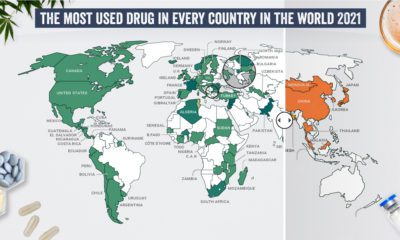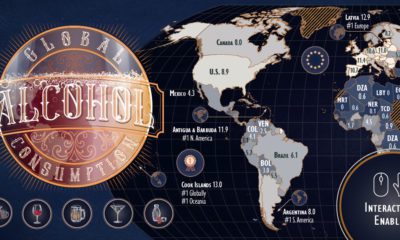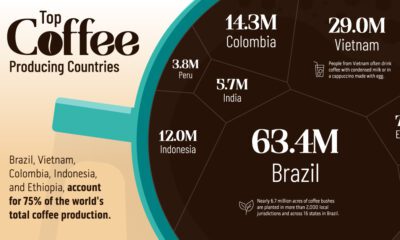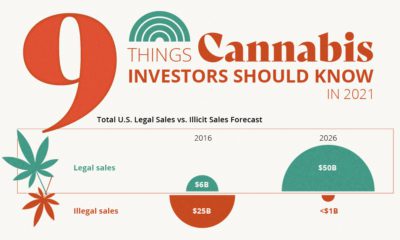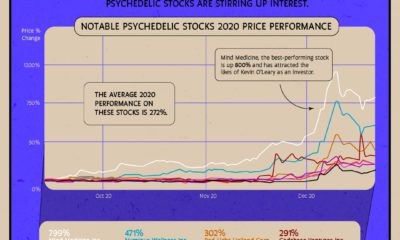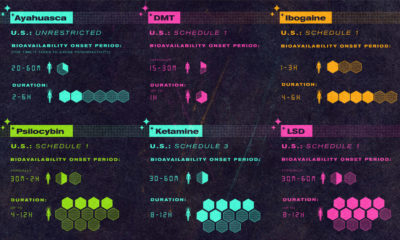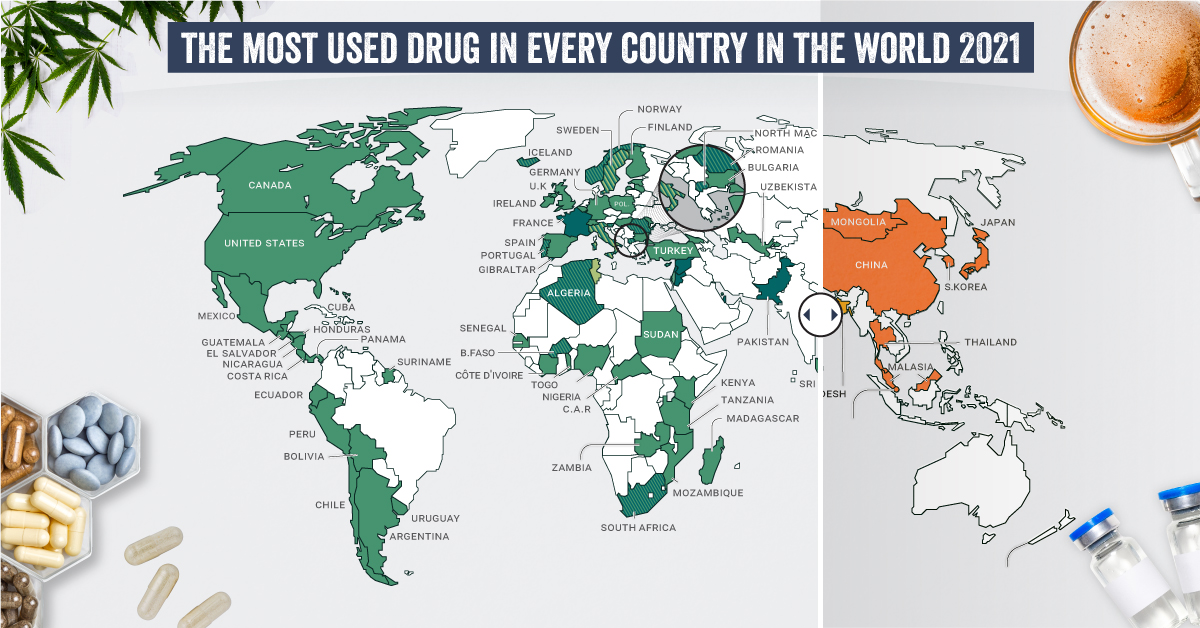But while awareness of these products is at an all-time high, false or misleading information continues to cause confusion, and creates an unnecessary barrier for consumers who want to experiment with, or try different products. For example, 69% of cannabidiol (CBD) products are reported to have inaccurate labeling, so it’s no surprise that some consumers are uncertain about the suitability of these products and are hesitant to invest. Today’s graphic from Elements of Green dives into the differences between popular cannabis products, CBD oil and hemp seed oil—more commonly known as hemp oil— and the common misconceptions that are inhibiting consumers from entering the space en masse.
Same Plant, Difference Characteristics
Typically, both CBD oil and hemp oil originate from the hemp plant, a non-psychoactive cannabis plant. Therefore, it typically does not result in any intoxicating effects. However, many consumers mistakenly believe that CBD or hemp products will get them high, when in fact it is the marijuana plant—hemp’s psychoactive cousin—that can induce mind-altering effects. Even though both oils are extracted from the same plant, they each have very different characteristics and uses that consumers should be aware of.
CBD Oil
CBD oil is extracted from the flowers, leaves, stems, and stalks of hemp plants, and contains high levels of the naturally occurring CBD compound. Various CBD oil formats include tinctures, vape oil, and capsules, which are commonly used for their proven therapeutic benefits, such as:
Pain management Relaxation Stress relief Treatment of medical conditions such as epilepsy, schizophrenia, multiple sclerosis, and arthritis Reduction in anxiety Sleep aid
When it comes to product labeling, consumers should be aware that different types of CBD oils exist, depending on the chemical compounds—known as cannabinoids—they contain.
CBD Isolate: Pure CBD, with no other cannabinoids such as THC Full-spectrum CBD oil: Contains CBD among other cannabinoids, including THC Broad-spectrum CBD oil: Contains CBD among other cannabinoids, with no THC
These oils are used in a wide variety of consumer products such as beverages, beauty products, and even pet food.
Hemp Oil
Hemp oil, on the other hand, is extracted from hemp seeds and contains no cannabinoids such as CBD and THC. It is used more like a traditional cooking oil, but can also be found in topical creams and lotions. More recently, hemp oil is being hailed for its use in industrial products such as concrete, bio-plastics and fuel. While it has huge potential for use in both consumer and industrial products, its benefits differ slightly to CBD oil:
Source of plant-based protein and rich in fatty acids and antioxidants Reduces inflammation Reduces severity of skin conditions such as acne, eczema, or psoriasis Anti-bacterial properties Could reduce PMS or menopause symptoms
Consumers should ensure that hemp oil is listed as the active ingredient on the product’s packaging, but it may also be listed as cannabis sativa seed oil.
Busting the Myths
While there is strong scientific evidence to support the efficacy of CBD oil and hemp oil, companies need to commit to both appropriate and safe labeling regarding dosage levels and ingredients. Following that, previously held stigmas and misconceptions should slowly disintegrate as these products become more widely available and consumers increase their knowledge and understanding of their benefits. Considering that the popularity of cannabis consumer products has only exploded over the last decade, initial confusion surrounding them is to be expected, and the true potential of these products is yet to be realised. on Humans have a storied and complicated relationship with drugs. Defined as chemical substances that cause a change in our physiology or psychology, many drugs are taken medicinally or accepted culturally, like caffeine, nicotine, and alcohol. But many drugs—including medicines and non-medicinal substances taken as drugs—are taken recreationally and can be abused. Each country and people have their own relationship to drugs, with some embracing the use of specific substances while others shun them outright. What are the most common drugs that are considered generally illicit in different parts of the world? Today’s graphics use data from the UN’s World Drug Report 2021 to highlight the most prevalent drug used in each country.
What Types of Common Drugs Are Tracked?
The World Drug Report looks explicitly at the supply and demand of the international illegal drug market, not including commonly legal substances like caffeine and alcohol. Drugs are grouped by class and type, with six main types of drugs found as the most prevalent drugs worldwide.
Cannabis*: Drugs derived from cannabis, including hemp. This category includes marijuana (dried flowers), hashish (resin), and other for various other parts of the plant or derived oils. Cocaine: Drugs derived from the leaves of coca plants. Labeled as either cocaine salts for powder form or crack for cocaine processed with baking soda and water into rock form. Opioids: Includes opiates which are derived directly from the opium poppy plant, including morphine, codeine, and heroin, as well as synthetic alkaloids. Amphetamine-type Stimulants (ATS): Amphetamine and drugs derived from amphetamine, including meth (also known as speed), MDMA, and ecstasy. Sedatives and Tranquilizers: Includes other drugs whose main purpose is to reduce energy, excitement, or anxiety, as well as drugs used primarily to initiate or help with sleep (also called hypnotics). Solvents and Inhalants: Gases or chemicals that can cause intoxication but are not intended to be drugs, including fuels, glues, and other industrial substances.
The report also tracked the prevalence of hallucinogens—psychoactive drugs which strongly affect the mind and cause a “trip”—but no hallucinogens ranked as the most prevalent drug in any one country. *Editor’s note: Recreational cannabis is legal in five countries, and some non-federal jurisdictions (i.e. states). However, in the context of this report, it was included because it is still widely illicit in most countries globally.
The Most Prevalent Drug in Each Country
According to the report, 275 million people used drugs worldwide in 2020. Between the ages of 15–64, around 5.5% of the global population used drugs at least once. Many countries grouped different types of the same drug class together, and a few like Saudi Arabia and North Macedonia had multiple different drug types listed as the most prevalent. But across the board, cannabis was the most commonly prevalent drug used in 107 listed countries and territories: How prevalent is cannabis worldwide? 72 locations or more than two-thirds of those reporting listed cannabis as the most prevalent drug. Unsurprisingly these include countries that have legalized recreational cannabis: Canada, Georgia, Mexico, South Africa, and Uruguay.
How Common Are Opioids and Other Drugs?
Though the global prevalence of cannabis is unsurprising, especially as it becomes legalized and accepted in more countries, other drugs also have strong footholds. Opioids (14 locations) were the most prevalent drugs in the Middle-East, South and Central Asia, including in India and Iran. Notably, Afghanistan is the world’s largest producer of opium, supplying more than 90% of illicit heroin globally. Amphetamine-type drugs (9 locations) were the third-most common drugs overall, mainly in East Asia. Methamphetamine was the reported most prevalent drug in China, South Korea, and Japan, while amphetamine was only the most common drug in Bangladesh. However, it’s important to note that illicit drug usage is tough to track. Asian countries where cannabis is less frequently found (or reported) might understate its usage. At the same time, the opioid epidemic in the U.S. and Canada reflects high opioid usage in the West. As some drugs become more widespread and others face a renewed “war,” the landscape is certain to shift over the next few years.
